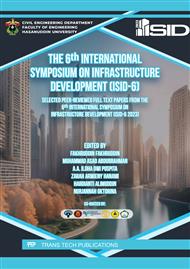p.141
p.151
p.157
p.165
p.177
p.185
p.195
p.207
p.217
Analysis of Excavation Method and Support System Using Empirical Method of Pamukkulu Dam Intake Tunnel, South Sulawesi, Indonesia
Abstract:
The Pamukkulu Dam has an intake structure in the form of a tunnel (underground structure) which functions to drain water for irrigation and raw water in Takalar Regency, South Sulawesi Province, Indonesia. This study aims to determine the classification of rock masses, which were carried out based on the Geological Strength Index (GSI) and Japan Society for Civil Engineers (JSCE), to analyze the intake tunnel's excavation method and support system. The research method included surface geological mapping and evaluation of the core drill along the intake tunnel to determine the classification of rock masses along the intake tunnel. Surface geological mapping indicated that the lithologies in the intake tunnel were basalt and breccia. Based on the core drill evaluation results, the rock masses along the tunnel alignment based on the GSI are classified as very good, and the recommended tunnel excavation method is blasting. Based on the JSCE, the rock masses along the tunnel alignment are classified into rock category B. Full-face full excavation is recommended with an advance of 2 m. Based on the JSCE, the recommendation for a support system is a rock bolt with a length of 4 m, spacing of 1.5 m, shotcrete of 10 cm, and lining of 40 cm on the crown and wall.
Info:
Periodical:
Pages:
177-184
Citation:
Online since:
July 2025
Price:
Сopyright:
© 2025 Trans Tech Publications Ltd. All Rights Reserved
Share:
Citation:


